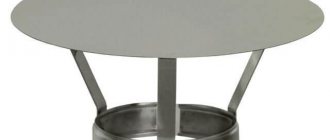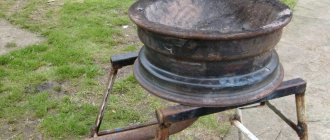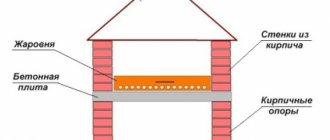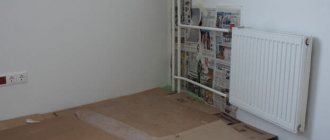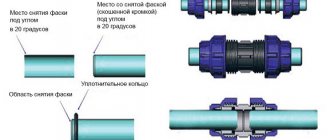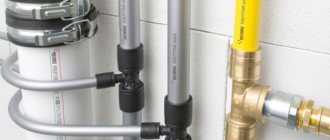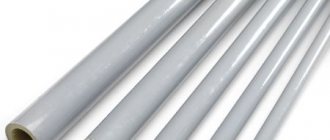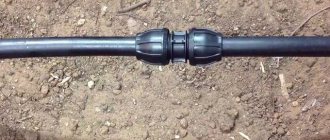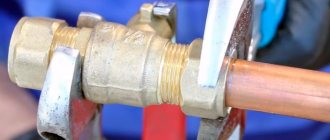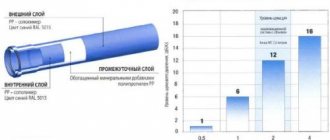Material characteristics
Zinc is a metal with a melting point of 419 C.
The composition of the zinc coating includes an alloy of zinc (99.97%), aluminum, lead and other metals. The layer thickness is standardized by GOST and ranges from 10 to 60 microns.
In air, zinc is covered with a thin film of oxide, which acts as a protection for steel from corrosion.
Galvanized steel is resistant to precipitation and temperature changes.
Convenient to process, easy to bend, roll, stamp and other mechanical loads.
Can galvanized pipes be used for chimneys?
Chimneys with zinc coating are used under certain conditions.
When zinc is heated to 419°, it begins to release substances harmful to humans. Therefore, it is recommended to install outlets made of this material in smoke exhaust systems where the temperature does not exceed 350°C.
The 2009 Ministry of Emergency Situations rules prohibit the use of metal smoke removal agents for coal-fired stoves.
In addition, a single-wall galvanized outlet will burn out after one or two seasons. In practice, it is used as an outer casing in double-walled structures with insulation.
Advantages and disadvantages of galvanized pipes
Users include the following advantages of a galvanized chimney pipe:
- long-term resistance to corrosion,
- rapid heating of the chimney and, as a result, ensuring good draft,
- simple assembly method,
- a smooth surface inside the channel, which does not allow soot to linger on the walls,
- Possibility of venting through the wall of the building.
Flaws:
- short service life of a single-wall outlet,
- when cutting a product, the cut lines begin to rust after a short time,
- minor damage leads to destruction of the protective layer,
- formation of a large amount of condensate.
Calculation of the required cross-section and height of the pipe
To ensure good aerodynamics and adequate traction, it is necessary to comply with the rules prescribed in the relevant SNiP. They regulate the standards for the height and diameter of the pipe section for chimneys.
The height of the pipe depends on the type of roof. Its minimum possible value is 5 m, if measured from the heating device to the head. In addition, it is necessary to calculate the height of the part of the pipe protruding above the roof.
Above a flat roof, the pipe must rise no less than 50 cm. If the roof has a slope, the height of the pipe depends on its location in relation to the ridge of the roof. The location options are as follows:
- Up to 1.5 m from the ridge. In this case, the recommended pipe height is 50 cm higher than the most protruding part of the roof.
- From 1.5 to 3 m from the ridge. With this arrangement, the head should form a straight horizontal line with the roof ridge.
- More than 3m. In this case, the height of the protruding part of the pipe should be such that the angle between the ridge and the head is 10°. In this case, the pipe is located below the ridge.
Special formulas have been invented to calculate the cross section. They are very complex and to use them you need to know how much fuel is burned per hour of operation of the device, what the inlet and outlet temperatures are, as well as the coefficient for each type of fuel. To simplify the task of calculating the pipe cross-section, simplified rules are used:
- For devices with a power of less than 3500 W, the pipe cross-section must be at least 140 mm x 140 mm.
- For devices with a power from 3500 to 5000 W, the cross-section must be at least 140 mm x 200 mm.
- For devices with power from 5000 W to 7000 W - 140 mm x 270 mm.
What is better galvanized or stainless steel?
It is recommended to make the initial section of the chimney channel from the boiler, where the temperature is especially high, from stainless steel. The inner pipe of the sandwich is made from it, which allows it to be used in any smoke removal system.
Of course, this type of steel is the most durable and rust-resistant. In these parameters it is superior to galvanization. Its main drawback is its high price.
To reduce the cost of sandwiches, galvanization is used to make the casing.
Selection tips and approximate price
Manufacturers offer a large selection of both single-circuit galvanized bends and sandwich pipes with a galvanized shell. There are certain parameters by which you should select elements for the chimney:
- the diameter of the boiler outlet pipe must be equal to or less than the cross-section of the chimney outlet,
- attached chimneys can have no more than three bends along the entire length of the channel.
- Manufacturers indicate the required chimney diameter for boilers in the unit’s passport,
- The wall thickness for the outer casing must be at least 0.5 mm, usually 0.55 mm is used.
The price of single-circuit galvanized steel pipes depends on the diameter and thickness of the sheet metal. A meter bend d=110 mm costs 190 rubles, and d=250 mm costs 390 rubles.
A stainless steel + galvanized sandwich of the same diameter, 0.5 mm thick and 100 cm long will cost 1,230 rubles.
How to make a chimney from a steel pipe with your own hands?
The chimney is an important part of heating appliances running on gas, solid or liquid fuel. In fireplaces, stoves, baths and boilers, it is important to maintain a certain level of draft in order to clean the air from combustion products. The correct choice of chimney pipe is the basis for the safe operation of the heating device. Errors in chimney construction can lead to life-threatening situations.
Making galvanized pipes with your own hands
The main feature of a factory-made galvanized pipe is a reliable welding seam.
If you have an argon unit at home and you are a big welder, this makes a difference. Surely what you will get is not a pipe, but a feast for the eyes.
First you need to choose a galvanized sheet for the pipe. Professionals make bends with walls 0.55 mm thick. At the same time, it must be taken into account that the thinner the material, the easier it is to bend.
Required tools and materials
You will need:
- hand scissors for metal,
- mallet with a wooden striking part,
- roulette,
- square,
- metal ruler,
- pencil, preferably a construction pencil,
- pliers.
For the convenience of bending work, a simple workbench is equipped where markings are made. A metal corner (4040 mm or more) with a length of at least 100 cm, a steel round shape of the required diameter, is attached to the table.
Cutting out the workpiece
Let's look at how to make a pipe with a cross-section of 100 mm.
Calculate the width of the workpiece:
- determine the circumference as the product of the cross section and the value of pi equal to 3.14,
- 15 mm are allocated for the bends for the connecting seam.
In total, for a 100 mm bend, a workpiece with a width of 3.14100 mm + 15 mm ≈ 330 mm is cut out.
Take into account that the pipes are made slightly cone-shaped for ease of installation using the socket method. Therefore, one side measures 330 mm, the other 340 mm (in the figure).
Formation of a profile
On the cut-out workpiece, mark a fold line for a fold of 5 mm on one side, twice 5 mm each on the other.
The sheet is laid on a workbench, the edge is aligned with the corner. Using a mallet, gradually bend it at a right angle. Then the workpiece is turned over and the fold is placed on the canvas.
In the same way, a 10 mm bend is made on the other edge of the sheet, and another 5 mm wide on it.
Next, the workpiece is manually bent on the forming tube, using a mallet.
Processing the butt seam
After obtaining a round shape of the workpiece, it is placed on a round form or an additional corner, the folds are connected into a lock, tapping them along the edges with a mallet. At the narrow end of the future pipe, the folds are slightly cored. Tap the entire length of the joining seam with a mallet, compacting the folds. The seam becomes almost permanent.
Processing the seam joint
The final stage involves processing the joining seam, that is, crimping it. To do this, the upper part of the L-shaped fold is folded down, wrapping the edge of the other fold. The result should be a kind of sandwich located perpendicular to the pipe. To obtain a joining seam, you need to press the sandwich to the product.
For greater reliability, the joining seam is strengthened using rivets. However, do-it-yourself tin pipes using this joining method do not require additional reinforcement.
Source
Is it possible to paint a galvanized chimney?
It is possible and even necessary to paint galvanized steel. Over time, rust begins to penetrate through the zinc layer and paint will be a good means of additional protection.
However, a galvanized surface does not have the same adhesion as, for example, black steel. Therefore, ordinary oil and alkyd paints, which oxidize upon contact with zinc, lose adhesion and peel off the painted surface, are not suitable here.
Special compositions have been invented:
- tsikrol, matte acrylic paint with high coverage, light fastness and adhesion,
- Nerzhalux enamel, characterized by high adhesion and wear resistance,
- aluminum enamel Serebrol, which reliably protects against rust and is suitable for outdoor use,
- a number of other compounds that can provide long-term protection from rain, exposure to sunlight, temperature changes, without causing harm to the human body.
It is better to paint no earlier than a year after installing the chimney. During this time, its surface will acquire the desired roughness and create reliable adhesion for coloring compounds.
How and with what to insulate a galvanized chimney
Among insulation materials, basalt wool is in first place - a reliable non-flammable product that is successfully used for thermal insulation and insulation of smoke removal systems. Other types of mineral wool are used as a cheap substitute, the main thing being the non-flammability of the material.
The outlet is wrapped with the selected insulation and secured with wire or other reliable and heat-resistant material. Then another pipe, larger in diameter, and usually made of galvanized steel, is placed on the insulated channel. It turns out to be a self-made sandwich. The inner pipe can be a stainless steel product.
Construction of galvanized products
Manufacturers produce single- and double-circuit modifications of these chimneys.
Single-circuit products made of galvanized steel are often installed inside the house or covered with brickwork.
To avoid the formation of condensation, it must be insulated. Without insulation, single-circuit chimneys made of galvanized steel are not recommended for use outside.
You can put it yourself in a kebab shop or barbecue room.
The double-circuit modification (galvanized pipe sandwich) is so named because it is multi-layered. It consists of three components, two pipes, internal and external, which are insulated using mineral wool or other fire-resistant insulation.
This design heats up quickly, which activates the operation of heating devices and minimizes the amount of moisture that accumulates on the walls.
By choosing a galvanized sandwich pipe, you can talk about an aesthetic appearance that harmoniously fits into the overall design of the exterior. In addition to the technology described above, structures are created from so-called black steel.
These galvanized sandwich pipes assume that the pipe installed inside will be made of ordinary steel.
Galvanized sandwich pipes for chimneys are used in houses with heating boilers, stoves or fireplaces. This is also the best option for baths and saunas.
Since the structure of the bathhouse differs from that of an ordinary house, in order to maintain a high temperature in the steam room, a sandwich structure is used, and the space between them is filled with mineral wool, which is thermal insulation of an environmentally friendly composition and at the same time it is not subject to fire at high temperatures.
